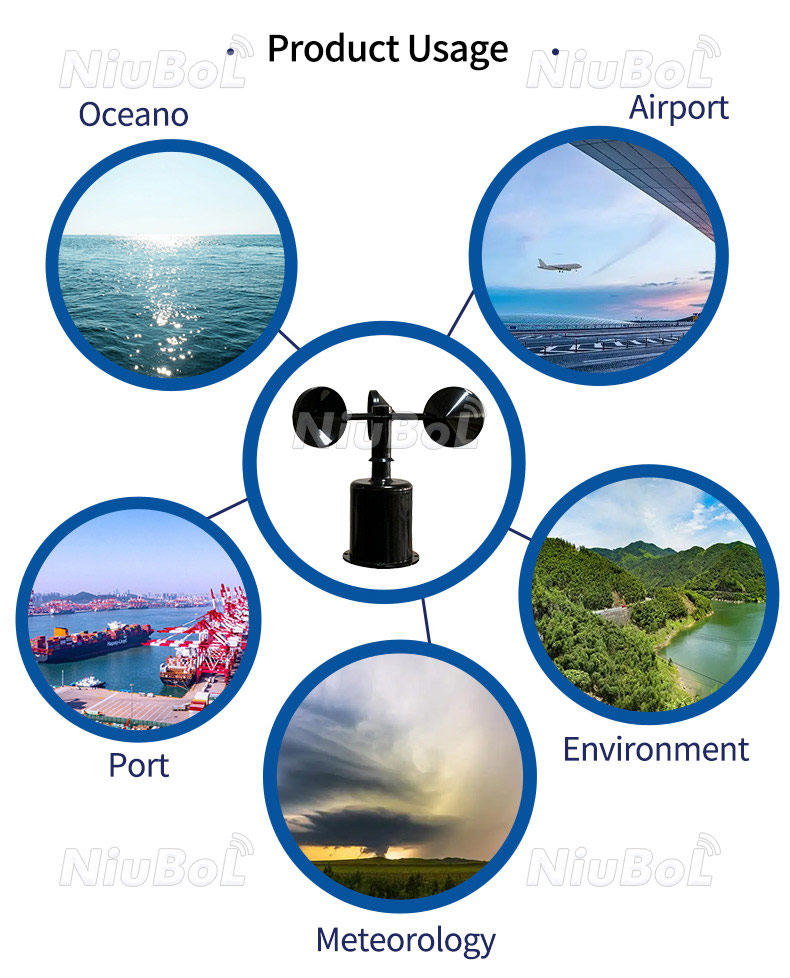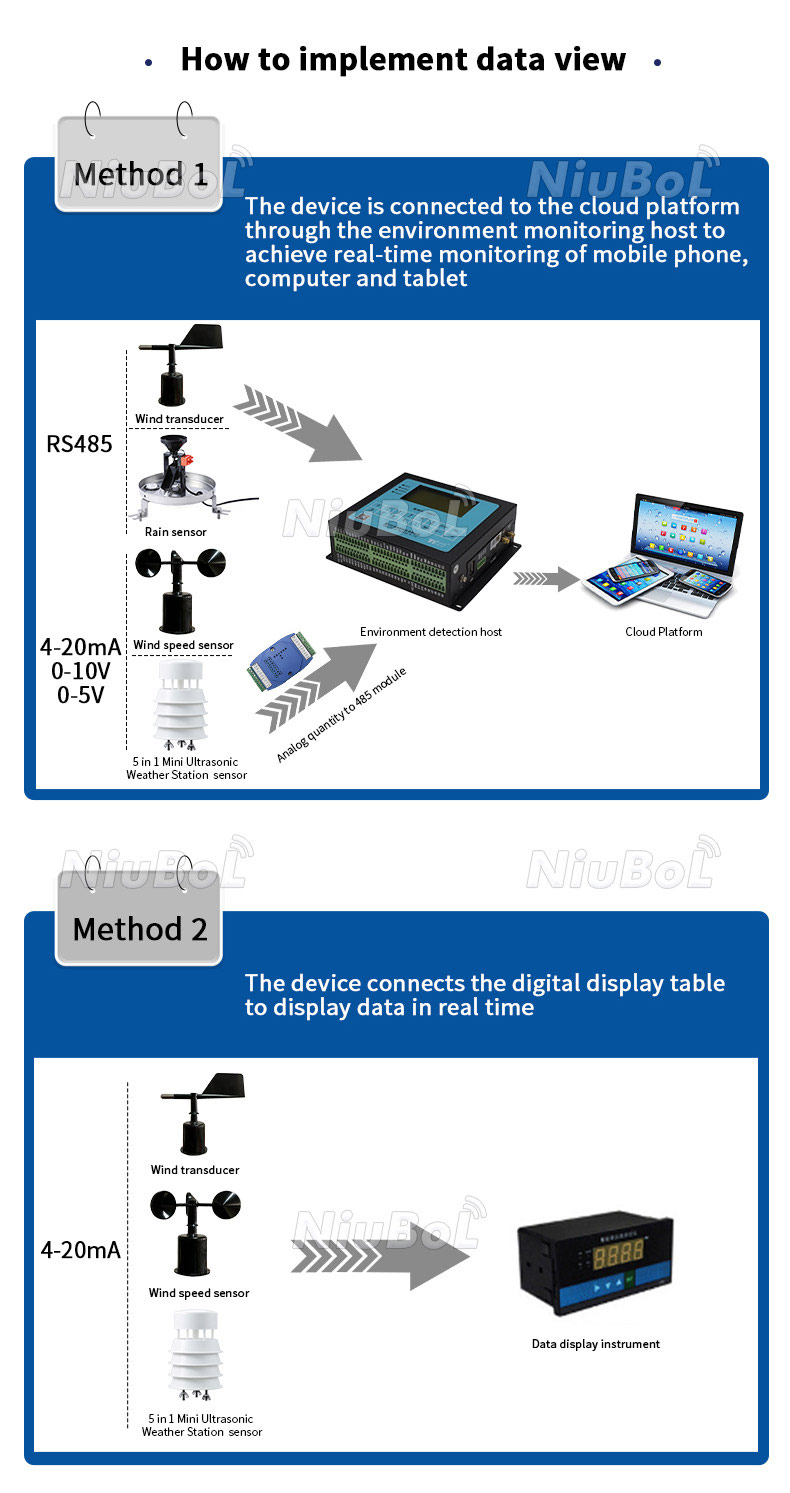

— Blogs —
—Products—
 Consumer hotline +8618073152920
Consumer hotline +8618073152920 WhatsApp:+8615367865107
Address:Room 102, District D, Houhu Industrial Park, Yuelu District, Changsha City, Hunan Province, China
Product knowledge
Time:2024-06-30 22:13:01 Popularity:2378
Wind speed sensors are devices used to measure wind speed, categorized into various types based on their principles of operation and application scenarios:
1. Mechanical Wind Speed Sensors:
- Types: Includes pole, cup, and propeller anemometers.
- Working Principle:
- Pole: Measures wind speed by the displacement of a sensitive element due to wind force.
- Cup: Measures wind speed based on the rotation speed of cups.
- Propeller: Calculates wind speed from the frequency of propeller rotation.
- Features: Directly responds to wind with mechanical motion, simple structure, but may be affected by mechanical wear affecting accuracy.
2. Ultrasonic Wind Speed Sensors:
- Working Principle: Uses the speed and direction of ultrasonic waves to measure wind speed. Sends ultrasonic pulses and calculates wind speed from the time difference and velocity changes of the echoes.
- Features: Fast response, high accuracy, strong interference resistance; suitable for aviation meteorology, industrial automation, etc.
3. Optical Wind Speed Sensors:
- Working Principle: Uses laser beams or infrared to measure wind speed. Determines wind speed by measuring the offset or scattering of laser beams or infrared in the wind.
- Features: Non-contact measurement, high accuracy, fast response; suitable for weather stations, aircraft flight control, etc.
4. Hot-Wire Wind Speed Sensors:
- Working Principle: Uses a hot-wire sensor to sense wind speed. Measures wind speed based on the heat dissipation rate of the hot wire in the airflow.
- Features: Suitable for measuring low-speed winds (<1m/s) and analyzing airflow quality, but requires temperature correction for accuracy.

5. Pitot Tube Wind Speed Sensors (Pressure-Type Anemometers):
- Working Principle: Calculates average wind speed across a cross-section based on Bernoulli's principle using measured dynamic pressure.
- Features: Suitable for wind speeds >3m/s; less accurate at low wind speeds; suitable for clean airflow conditions.
6. Vibrating Wire Wind Speed Sensors:
- Working Principle: Calculates wind speed by detecting changes in vibration frequency.
- Features: Suitable for aviation and meteorological applications; resistant to vibrations and shocks.
7. Tube-Type Wind Speed Sensors:
- Working Principle: Controls airflow through a tubular wind resistance element; calculates wind speed based on the pressure difference inside and outside the wind resistance element.
- Features: Suitable for wind speed measurement in harsh weather conditions.
8. Wind Bag Wind Speed Sensors:
- Working Principle: Measures wind speed by the deformation of a wind bag.
- Features: Provides high-precision wind speed measurements suitable for meteorological, aviation, and other applications.
9. Electromagnetic, Optoelectronic, and Resistive Wind Direction Sensors:
- Working Principle: Electromagnetic sensors use principles of electromagnetism; optoelectronic sensors utilize absolute Gray code discs and light-to-electric signal conversion principles; resistive sensors use structures similar to sliding resistors.
- Features: Accurately output corresponding wind direction information.

In summary, wind speed sensors vary widely, ranging from mechanical types to those based on ultrasound, optics, hot-wire, pressure, vibration, etc. When selecting a wind speed sensor, it's crucial to consider specific application scenarios and measurement requirements. Each sensor type has unique advantages and suitable applications; for instance, ultrasonic sensors excel in harsh weather conditions, while hot-wire sensors are better suited for low-speed wind measurement and airflow analysis.
NBL-W-SS-Wind-Speed-Sensors-Instruction-Manual-V4.0.pdf
NBL-W-DS-wind-direction-sensor-Manual.pdf
NBL-W-51MUWS-Ultrasonic-Integrated-Weather-Sensor-Instruction-Manual.pdf
Prev:How does a wind speed sensor work?
Next:What device is used to measure wind speed and direction?
Related recommendations
Sensors & Weather Stations Catalog
Agriculture Sensors and Weather Stations Catalog-NiuBoL.pdf
Weather Stations Catalog-NiuBoL.pdf
Related products
 Combined air temperature and relative humidity sensor
Combined air temperature and relative humidity sensor Soil Moisture Temperature sensor for irrigation
Soil Moisture Temperature sensor for irrigation Soil pH sensor RS485 soil Testing instrument soil ph meter for agriculture
Soil pH sensor RS485 soil Testing instrument soil ph meter for agriculture Wind Speed sensor Output Modbus/RS485/Analog/0-5V/4-20mA
Wind Speed sensor Output Modbus/RS485/Analog/0-5V/4-20mA Tipping bucket rain gauge for weather monitoring auto rainfall sensor RS485/Outdoor/stainless steel
Tipping bucket rain gauge for weather monitoring auto rainfall sensor RS485/Outdoor/stainless steel Pyranometer Solar Radiation Sensor 4-20mA/RS485
Pyranometer Solar Radiation Sensor 4-20mA/RS485
Screenshot, WhatsApp to identify the QR code
WhatsApp number:+8615367865107
(Click on WhatsApp to copy and add friends)
